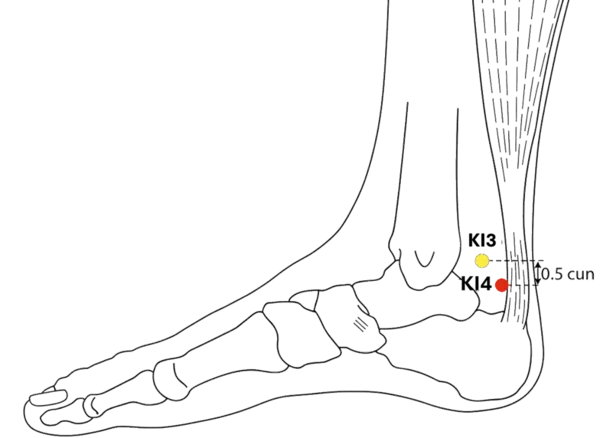KI-4 - Great Bell
大钟 - Dà zhōng
Point Region: Foot
KI-4, or 'Dazhong' (meaning 'Great Bell'), is the 'Luo-Connecting' point of the Kidney channel. Its name evokes the deep, resonant sound of a great bell, symbolizing its ability to connect to and harmonize with the other meridians.
As a 'Luo-Connecting' point, Dazhong serves as a communication hub between the Kidney and its partner meridian, the Bladder. It is also used to address a wide range of emotional and psychological issues, as it helps to anchor the spirit and calm the mind. Think of it as a 'great bell' that can ring out to quiet the noisy chatter of the mind and bring a sense of inner peace.
This point is a vital tool for addressing the deeper emotional aspects of Kidney imbalances, such as fear, anxiety, and a sense of 'rootlessness.' By stimulating this point, you can help to ground the spirit and restore a sense of security, much like the steady, calming sound of a bell.
Location & How to Find
Anatomical Location: Located on the medial aspect of the heel, just below KI-3.
How to Locate:
- Find the bony bump on the inner side of your ankle
- Move behind this bump toward your heel
- Continue down toward your heel from this area
- The point is on the inner side of your heel area

Primary Functions
Urinary & Kidney System
- Strengthens kidney yang qi
- Treats chronic kidney weakness
- Regulates urinary function
Musculoskeletal System
- Treats heel pain and plantar fasciitis
- Strengthens tendons and ligaments
- Addresses ankle instability
Nervous System
- Calms the mind and spirit
- Treats chronic anxiety
- Improves mental stability
Respiratory System
- Assists in grasping lung qi
- Treats chronic cough and asthma
Emotional & Mental
- Strengthens willpower
- Reduces fearfulness
- Promotes inner strength
Clinical Applications
Primary Indications
- Asthma
- Anxiety
- Heel pain
- Palpitations
- Respiratory problems
- Nervousness
- Foot pain
- Heart problems
Related Health Concerns
Common Conditions:
Related Acupoints
Select a point to learn about its location, primary functions, clinical applications, and protocols.
KI-4 Protocols
N/A
Important Precautions
- Recent heel surgery
- Severe heel fracture
- Acute respiratory distress